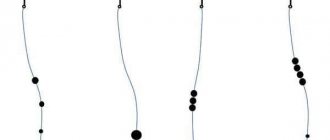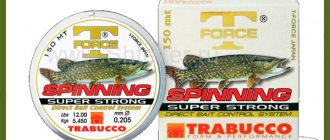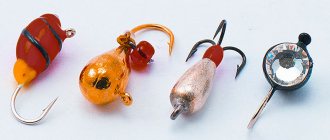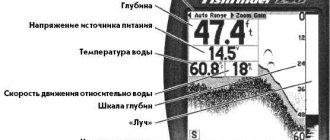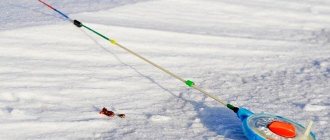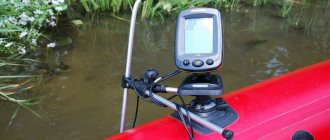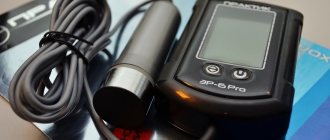Features of pike behavior
Pike is one of those fish that every fisherman, both beginner and professional, wants to catch. It is not so easy to quickly detect this predator, and an echo sounder will be your best assistant. However, its appearance on the device screen does not always guarantee a good bite, because if the pike is not hungry or the oxygen level is not normal, then it is unlikely to respond to any manipulations. But you shouldn’t despair, because there are a number of tips with the help of which you still managed to catch this predator.
- The best technique for catching pike is vertical fishing, as it allows you to outsmart the fish.
- If the pike was found at a depth of less than 5 meters, then you should not use spoons, as it will hear all the noise and see the boat. In this case, it is recommended to use spinning.
- Pike responds well to the ultrasonic signal of the echo sounder, which helps to bring it out of the half-asleep state in which it quite often remains.
When deciding to use an echo sounder for pike fishing, it is important to know how it will be displayed on its display. If high-quality two-beam models are used, the pike will be displayed in the form of elongated rectangles. On the monitor of single-beam echo sounders it is shown as a constant visual signal. In addition, you need to remember that it is not a schooling fish and therefore always stays alone.
Useful rules for catching pike with an echo sounder
If you confidently decide to use an echo sounder to catch the main predator of reservoirs, then you need to remember a few main rules:
- You should not try to catch exactly those pikes that were highlighted by the echo sounder, especially if their population in the reservoir is quite large. They may not respond to your manipulations, and time will be lost;
- It is recommended to look for areas where several fish are visible on one edge, located very close to each other. The optimal depth in this case is from 5 to 7 meters. Once detected, such an area is marked with buoys;
- if the pike was found at a depth of less than five meters, then it is recommended to catch it using a spinning rod. Tests should be performed at intervals of 20-30 minutes;
- if there are few pikes in the reservoir, and the echo sounder is single-beam, then it is better to look not for individual fish, but for the best places for their habitat;
- if a predator is not detected in its frequent places of residence or quickly flashes on the monitor, then this indicates the presence of a zhor. In this case, you need to postpone the search and start fishing.
Using an echo sounder when fishing for pike allows you to monitor its behavior and thereby adjust your actions. Thanks to this, fishing becomes not only more successful, but also exciting.
Fishing with an echo sounder
Today we will not analyze the technical subtleties of the next invention of civilization. But let's look at the echo sounder through the eyes and other senses of the fish. This shaitan device is used by almost all fishermen - both industrialists and amateurs, and, unfortunately, poachers. It is also not neglected by underwater hunters, divers-photographers, freedivers and all other categories of citizens related to the underwater world. An echo sounder is especially helpful in winter, because then many external landmarks disappear, by which the location of the fish can be determined.
Minimum technical specifications
The first echo sounder saw the light, or rather water, in 1957. Therefore, it is difficult to call it a technical novelty. But since then this device has been improved endlessly. The basic principle of operation is to combine information obtained from sound wave sources, a microphone and a stopwatch. The echo sounder is programmed with speed, distance and a structured image is built on the screen. The rest concerns the details and features of a specific model, adapted for a specific type of reservoir, climate zone and task area facing fishermen or any other users.
What types of echo sounders are there? Monochrome and color; Nowadays there are excellent touch screens. 3D devices are popular. They provide a clear and “intuitive” picture of the situation under water. The only thing is that such models are several times more expensive. There are forward-looking echo sounders: they are installed on the bow of the vessel and they are used to follow the fish (then you can immediately see how not to run aground). There are devices with a float that can be cast with a fishing rod. Only such models show mainly the relief, not the fish. On large bodies of water a GPS function is required. The built-in Wi-Fi transmitter, to which you connect a smartphone or tablet, can also be useful.
The cornerstone of using a fish finder
There is nothing absolutely beautiful and absolutely terrible. This is also true for the echo sounder. Retrogrades and other enemies of everything progressive persistently spread the opinion that an echo sounder with its waves drives away and scares away fish. I turned to physicists for a competent assessment. None of them answered categorically - yes or no. Reminds me of the situation with waves from a cell phone. There is also no direct evidence of harm. However, it is known that death occurs in humans at frequencies as low as 4 Hz. The human ear hears in the range from 16 Hz to 13 kHz. Moreover, if ultrasound of a higher frequency is played, then a person does not formally perceive it, but headaches appear.
If you follow this logic, then the poor fish that fell within the range of the echo sounder rays will begin to get a migraine. But the underwater inhabitants cannot tell about this. In scientific laboratories they record some discomfort in fish, but it is not entirely clear whether it is caused by the experimental conditions. Moreover, fish have a difficult pain threshold. It is greatly overestimated, as is the sensitivity threshold (compared to the human one). It is clear that people should not be exposed to the waves emitted by an echo sounder. Of course, you will not die, but headaches and attacks of unmotivated aggression are possible. First of all - to the fish. This is fraught with overfishing. So take care of yourself and the fish! By the way, about ten years ago Western scientists studied the influence of harmful radiation under water on human reproductive and mental functions.
Read: Tarpon Fishing
We hope that scientists will finally conduct fundamental research on this topic, but for now we have to use fragmentary scientific data, observations of scientists and fishermen, as well as other pseudo-scientific information.
Factual information
Back in the middle of the last century, ichthyological physiologists discovered that fish are capable of detecting sounds with a frequency ranging from 5 Hz to 13 kHz, that is, in a wider range than humans. Vibrations generated in the air do not reach the ears of fish well, because these waves are almost completely reflected from the water surface. Surely you have repeatedly observed how fish swimming in a river near the surface of the water do not react to strong noise from the shore at a distance of 8-10 m. It is important that any noise created in the water irritates the fish even at a considerable distance. Fish perceive sounds with a frequency of 13-16 kHz through the auditory labyrinths in the head and through the skin. This means that when fishing, it is advisable to behave quietly, without creating unnecessary noise in the water.
Scientists have found that fish perceive mechanical and infrasonic vibrations with frequencies of 5-16 kHz with their lateral line. The frequency at which most echo sounders operate is 250 kHz. This means that fish cannot detect these waves in any way. Each case of scaring away fish with an echo sounder must be analyzed step by step. Most likely it will turn out that the fish were afraid of the noise and mechanical waves created by the boat, or its sharp shadow.
However, there are some scientific hypotheses and facts that demonstrate (not always conclusively) that a negative effect exists. About fifteen years ago, American and European scientists began to study the effect of echo sounder radiation on fish in the reproductive stage (with ripe eggs and milt). Part of the scientific community has suggested that even due to short-term irradiation, gene mutations in future offspring are possible (for example, forked fins, three tails, scales of a different color and other developmental defects). The experience of Chinese breeders was cited as one of the arguments. They developed new varieties of golden crucian carp using various physicochemical effects on eggs and juveniles. But there is no need to talk about the mutational impact of echo sounders on the gene pool of the ichthyofauna of our waters. If this assumption were true, then in Russian reservoirs, where fish are actively caught from boats, everything would be swarming with mutants. While in our waters mutants appear as a result of the actions of poachers or careless business executives with their harmful chemical emissions, I don’t understand why.
Read: Pond Ecosystem
Interspecies differences in fish response to echo sounder
Ten years ago, most fishermen were sure that fish were trying to escape from the echo sounder coverage area as quickly as possible. There was even a “black list” among fishermen of the fish most sensitive to search rays. It included pike perch, perch, ruffe, grayling, trout and some others.
Cyprinids were considered thicker-skinned: they were practically not affected by echo sounder provocations. It is reliably known that silver bream, bream, roach and crucian carp rarely change their location due to the working device. And pike and catfish react even less to the echo sounder. This may be due to the fact that carp fish are open-vesical (the swim bladder directly receives air), and perciformes are closed-vesical (air enters the swim bladder from oxygen dissolved in the blood). Fish use their swim bladder, among other things, to perceive various sound (and ultrasonic) signals. This is not a scientific fact, but a logical assumption.
Winter period
It's winter outside. And as we have already noted, it is now that an echo sounder is really needed. Only with it can you quickly measure the depth in the right place under the ice. The main thing is not to forget to charge it in a timely manner, otherwise it may quickly discharge in the cold. Some manufacturers produce models specifically for Russia, with special frost-resistant and energy-intensive batteries. These work even down to -40°C. The main thing is that in the place where you will measure the depth, the ice is cleared of snow and there are no air bubbles or other obstacles in it. They can be confusing. For winter fishing, it is better to take echo sounders whose depth range is 1-25 m. And it does not matter that in your reservoir only fantastic drill worms can penetrate to such a depth. In this case, the depth measurement range correlates with power.
It's all about math
When a powerful echo sounder, designed for depths of over 200 m, is used on a shallow river, even the naked eye can see how it affects underwater inhabitants. And even for species declared “thick-skinned” such as pike and catfish. Right on the echo sounder screen you can see how potential trophies quickly swim away in an unknown direction. But when working with low-power echo sounders, this effect is not observed. To understand this, let's turn to mathematics.
Read: Fish hybrids
According to the manual, many low-power echo sounders have a “direction finding” angle of about 15-20°. At a depth of 2-3 m, it covers a circle with a diameter of about 1 m. If the depth is 10-12 m, then the diameter of the circle is already 2.7-3 m. And at a depth of 20-25 m, the circle increases to 5-7 m. However, all , what is in the field of view of the echo sounder is visible on the screen. For many models, the depth and density of the bottom are displayed in digital values, the relief is displayed as a static dotted line, and the fish are displayed as moving stripes (or small fish). Echo sounders from different companies will have different interfaces, but the meaning will not change. If you want a high-quality image of even small and insignificant elements of the bottom topography and living objects, you will need a screen with a large number of pixels. True, there is again a controversial opinion: the more pixels, the more comfortable it is for you to read information about the reservoir and the more unpleasant it is for the fish to be under the rays of your device (although this, again, is a debatable point).
In addition, some consider fish to be quite mathematicians, capable of counting how many rays an echo sounder emits in their direction. Of course, the operation of a two-beam (or better yet, a three-beam) device with a large field of view is much more informative than the readings of a single-beam echo sounder. The conversion signal as an image on the monitor is more complete and accurate. But there are smart people who warn that such multi-beam echo sounders have a stronger effect on the nervous system of fish and scare them away more than single-beam ones. And many fishermen believe that the more serious and popular the manufacturer of the echo sounder, the less intimidating it is to underwater inhabitants.
In conclusion, I will give some data on ichthyological stereometry. Often the coverage area depends not only on the number of echo sounder beams, but also on many other physical factors. A fisherman who cares about fish must understand: a wide coverage area is not always better than a narrow one. A device with a wide viewing angle will scan more water below you, but think about whether the screen has enough pixels, will the image merge into one spot? A powerful echo sounder reaches greater depths, but has a smaller coverage area. Well, let’s hear the opinion of skeptics: the larger the coverage angle, the more the echo sounder scares the fish. As always, there is no balance and equilibrium in desires and possibilities.
In this article we mainly used observations from anglers. We hope scientists will study this issue in more detail. Perhaps some well-known manufacturer of echo sounders will finance such research, because they are not at all budgetary. And next time we will be able to operate with more scientific information.

